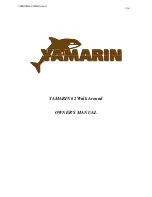
Spreader Ends
Class
Bracket Connection Pin
Primary
Adjuster
Laser Vago
Fwd
3B
7
. Raise the mast and position the mast heel on
the mast step. Th
e mast heel recess/slot should
straddle the bolt in the mast step. (fi gure 8)
(Note - Th
is is a two person operation as
someone will need to hold the mast upright
while shrouds and forestay are connected
- Ensure that there are no overhead power
cables)
8
.Attach the shrouds to the shroud anchor
point with the adjuster pin position in the 4th
hole down on the back of the vernier adjuster.
(fi gure 9a) (fi gure 9b)
9
. Temporarily attach the forestay around the jib
tack bar (not the furling drum). (fi gure 10)
10
. Shackle the lower shrouds to the shroud
anchor points ensuring that a multiple thick-
ness line strop of approximately 125 mm in
rigged length is used between the shackle and
the hard eye in the end of each lower shroud
wire. Th
e shackle should be positioned be-
tween the stay adjuster and the ratchet block.
(Th
e ratchet block should always be at the
front). (fi gure 11)
11
. Loosely fasten the other end of the lower
shroud wires to the eye on the front face of the
mast using multiple thickness line strops.
(Note:
lower shroud tension is adjusted using
these line strops after the jib halyard has been
tensioned
).
(fi gure 12)
Remove the clevis pin and slide out the
spreader end hook. Slide the hook over the
shroud, and slide back into the spreader. Refi t
the clevis pin and split ring.
Security
All clevis pins must be fi tted with the fl at head
on top, and locked with a split ring. Tape all
split rings, pins and the outboard end of the
spreader extrusion. Th
is will reduce chafe
on the mainsail and prevent fl ailing sails/
halyards becoming damaged. Self-amalgam-
ating tape is best, but PVC electrical tape is an
adequate alternative.
12
. Attach the trapeze rings to hull mounted
shockcords by feeding the elastic loop
through the ring at the bottom of the
pulley. (
Note:
Trapeze kit is an optional
upgrade on the standard rig but is included in
the Race rig). (fi gure 13)
13
.Place the loop of elastic shockcord over the
metal trapeze ring and pull tight. (fi gure 14)
14
.
Tip:
Tie two double half hitch stopper
knots in the adjuster line (a hand width
apart). (fi gure 15)
5. Boom and Gnav
1
. Unpack the boom and Gnav tackle.
(fi gure 16)
2
. Attach the boom to the mast using the drop
nose pin. (Articulating toggle at the bottom).
(fi gure 17)
3
. Tie the Gnav control line from the boom to
the double block and becket at the base of the
mast the boat. (fi gure 18)
Tip:
Best practice is to use a bowline.
4
. Attach the Gnav strut to the Gnav anchor
point using the drop nose pin. (Articulating
toggle at the bottom with joint orientation as
shown). (fi gure 19)
5
. Th
read the mainsheet through the center of
the block attached to the bridle rope and tie a
half hitch stopper knot. (fi gure 20)
fi gure 19
fi gure 20
fi gure 16
fi gure 18
fi gure 17
fi gure 15
fi gure 14
fi gure 13
fi gure 9b
fi gure 8
fi gure 12
fi gure 11
fi gure 10
fi gure 9a




























